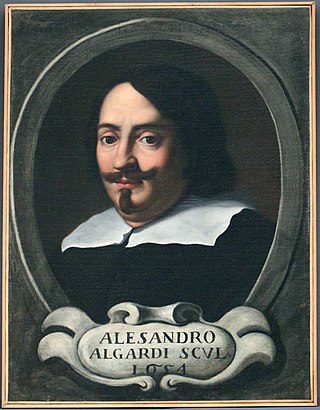
Alessandro Algardi was an Italian high-Baroque sculptor active almost exclusively in Rome. In the latter decades of his life, he was, along with Francesco Borromini and Pietro da Cortona, one of the major rivals of Gian Lorenzo Bernini, in Rome. He is now most admired for his portrait busts that have great vivacity and dignity.

Gian LorenzoBernini was an Italian sculptor and architect. While a major figure in the world of architecture, he was more prominently the leading sculptor of his age, credited with creating the Baroque style of sculpture. As one scholar has commented, "What Shakespeare is to drama, Bernini may be to sculpture: the first pan-European sculptor whose name is instantaneously identifiable with a particular manner and vision, and whose influence was inordinately powerful ..." In addition, he was a painter and a man of the theatre: he wrote, directed and acted in plays, for which he designed stage sets and theatrical machinery. He produced designs as well for a wide variety of decorative art objects including lamps, tables, mirrors, and even coaches.

Baroque architecture is a highly decorative and theatrical style which appeared in Italy in the early 17th century and gradually spread across Europe. It was originally introduced by the Catholic Church, particularly by the Jesuits, as a means to combat the Reformation and the Protestant church with a new architecture that inspired surprise and awe. It reached its peak in the High Baroque (1625–1675), when it was used in churches and palaces in Italy, Spain, Portugal, France, Bavaria and Austria. In the Late Baroque period (1675–1750), it reached as far as Russia, the Ottoman Empire and the Spanish and Portuguese colonies in Latin America. In about 1730, an even more elaborately decorative variant called Rococo appeared and flourished in Central Europe.

The Church of Saint Andrew on the Quirinal is a Roman Catholic titular church in Rome, Italy, built for the Jesuit seminary on the Quirinal Hill.

The Ecstasy of Saint Teresa is a sculptural group in white marble set in an elevated aedicule in the Cornaro Chapel of the church of Santa Maria della Vittoria in Rome. It was designed and completed by Gian Lorenzo Bernini, the leading sculptor of his day, who also designed the setting of the Chapel in marble, stucco and paint. It is generally considered to be one of the sculptural masterpieces of the High Roman Baroque. The sculpture depicts Teresa of Ávila, a Spanish Carmelite nun and saint, swooning in a state of religious ecstasy, while an angel holding a spear stands over her.
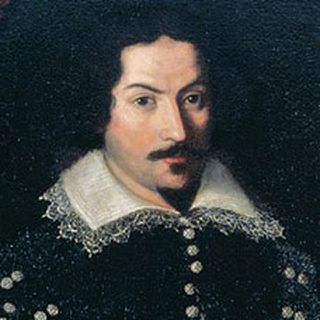
Carlo Maderno (Maderna) was an Italian architect, born in today's Ticino, Switzerland, who is remembered as one of the fathers of Baroque architecture. His façades of Santa Susanna, St. Peter's Basilica and Sant'Andrea della Valle were of key importance in the evolution of the Italian Baroque. He is often referred to as the brother of sculptor Stefano Maderno, but this is not universally agreed upon.

San Francesco a Ripa is a church in Rome, Italy. It is dedicated to Francis of Assisi who once stayed at the adjacent convent. The term Ripa refers to the nearby riverbank of the Tiber.
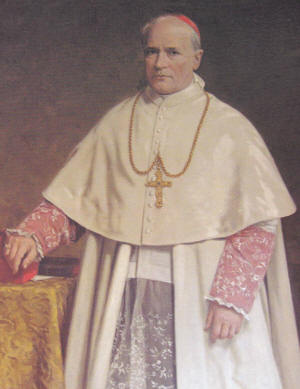
Girolamo Maria Gotti, OCD, sometimes erroneously called Giuseppe Gotti, was a friar of the Discalced Carmelite Order, who served in various offices of the Holy See as a cardinal of the Roman Catholic Church.

Blessed Ludovica Albertoni is a funerary monument by the Italian Baroque artist Gian Lorenzo Bernini. The Trastevere sculpture is located in the specially designed Altieri Chapel in the Church of San Francesco a Ripa in Rome, Italy. Bernini started the project in 1671, but his work on two other major works—The Tomb of Pope Alexander VII and the Altar of the Blessed Sacrament in St. Peter's Basilica—delayed his work on the funerary monument. Bernini completed the sculpture in 1674; it was installed by 31 August 1674.

Santa Maria della Scala is a titular church in Rome, Italy, located in the Trastevere rione. Cardinal Ernest Simoni took possession of the titular church on 11 February 2017. Santa Maria della Scala is a titular church.

Filippo della Valle was an Italian late-Baroque or early Neoclassic sculptor, active mostly in Rome.

Italian Baroque art is a term that is used here to refer to Italian painting and sculpture in the Baroque manner executed over a period that extended from the late sixteenth to the mid eighteenth centuries. Italian Baroque architecture is not covered.

The Church of San Marco in San Girolamo is a baroque parish church in Vicenza, northern Italy, built in the 18th century by the Discalced Carmelites. It houses various artworks by artists of the early 18th century from Veneto. The sacristy preserves its original furniture of the same period.
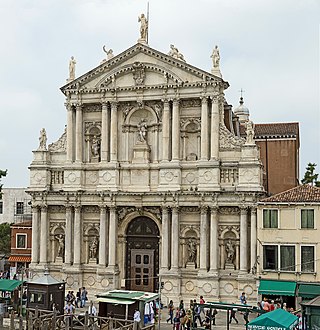
Santa Maria di Nazareth is a Roman Catholic Carmelite church in Venice, northern Italy. It is also called Church of the Scalzi being the seat in the city of the Discalced Carmelites religious order. Located in the sestiere of Cannaregio, near Venezia Santa Lucia railway station, it was built in the mid-17th century to the designs of Baldassarre Longhena and completed in the last decades of that century.

Santa Maria delle Grazie alle Fornaci fuori Porta Cavalleggeri is a Baroque style, Roman Catholic parish and titular church located at Piazza di Santa Maria alle Fornaci, south of Vatican City and north of the San Pietro train station in the Aurelio quarter. It was made a cardinalate deaconry by Pope John Paul II on 25 May 1985, and assigned it to Cardinal Duraisamy Simon Lourdusamy, then Prefect of the Congregation for the Oriental Churches. The church became vacant on 2 June 2014 after the death of Cardinal Lourdusamy. On November 11, 2016 it was announced that Mario Zenari will succeed him.
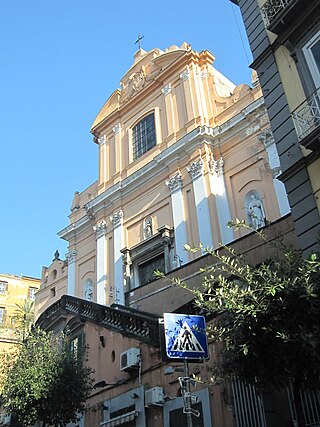
Santa Teresa degli Scalzi is a church in Naples, Italy, located in via Santa Teresa degli Scalzi, a wide street opened during 1806–1810, to connect the historic center of Naples to the zone of Capodimonte. The church is generally closed to the public.

Giovanni Antonio Guadagni, OCD, religious name Giovanni Antonio di San Bernardo – was an Italian Discalced Carmelite and cardinal of the Roman Catholic Church. His rise in the ranks became rapid after his maternal uncle became Pope Clement XII. He was soon after made a cardinal and served in various positions within the Roman Curia.
The Companion Guide to Rome is a composition for string trio by the American composer Andrew Norman. The complete work was first performed on May 30, 2010, by the Scharoun Ensemble at Radialsystem V in Berlin. The composition was a finalist for the 2012 Pulitzer Prize for Music.

The Church of Saint Teresa is a Baroque Roman Catholic church, located on Piazza della Kalsa, facing the Porta de Greci in the ancient quarter of the Kalsa of the city of Palermo, region of Sicily, Italy.

Triumph of the Name of Jesus is a 17th-century fresco painting by Giovanni Battista Gaulli. The fresco occupies the nave of the Church of the Gesù in Rome, with both fresco painting and stucco molding.



























